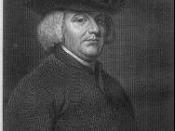Exposing Paley Paley's argument on the existence of God is well laid out and quite clear. Even so, it lacks the strength wherewith we can undoubtedly come to his same conclusion. There are a few points that weaken what seems like a solid argument and make us explore different possibilities and conclusions.
In his argument, he likens observing a watch on a heath to studying complex and adapted living organisms. If we were to question how the watch came to be, the answer that it had been designed and made by an intelligent being would be far more plausible than the assumption that it was formed by random events. Therefore, Paley states by the same reasoning that living organisms were designed, not accidentally produced.
This argument lacks strength because it concludes that just because the watch is very sophisticated, it must be the product of someone's scheme or plan. Who is capable of deciding when an object is complex enough to merit the assumption that it was designed, not simply the product of the right combination of materials.
There are purposes for a stone that are just as, if not more, important than those of a watch yet we seldom question how a stone came to be.
Paley says that we would be surprised to hear that the watch was "no proof of contrivance." (Sober, p118) He points to the fact that we cannot look at the watch and see the working mechanism without being convinced that it is the result of a plan made by some entity.
This objection caters to the very standardized thinking that is a part of the mould of our society. A link with a designer cannot be made solely on the level of complexity of an object, namely a watch. This form of thinking would have us look at a wedge and believe that, because of its' simplicity, it was not designed but merely existed in that state indefinitely in the past. Making it a surprise to find that the watch was not planned just leans on our weakness to claim most good things as the work of humans and forces us to lower our image of human ability if we think otherwise.
Paley could claim that it is the level of complexity that is proof of the planning. The different metals, not normally found together, shaped in such a way to move together uniformly are proof enough to convince us of this conclusion.
This claim states that random events do not occur on the earth that mix the substances so that all the 'ingredients' of a watch are present in one place. We know from observation that natural events, such as earthquakes and volcanoes, take place and constantly leave substances, like metals, mixed in a very unique fashion. Therefore it is entirely possible that the watch was formed by natural, random events on the earth and not by the scheme of some designer.
Another point that is important is the fact that we know very little or nothing about the watch or its' making. How can we be sure that the watch was designed when we don't even know exactly how it works or where the parts of it originated? Paley explains that we know enough about the matter for this argument. We know what the watch does and that we can control and change it to suit our needs. If we know this, and nothing else, it doesn't change our reasoning.
This is true because it shows how we don't need to have every fact in the light before we make an informed decision. The knowledge of the workings of the watch or where some of its' parts came from are not necessary for this argument. This information is just an accessory to the function and not the basis of any conclusion about the design of the matter. In science, there are many things left unknown about objects such as atoms, yet this does not stop scientists from making clear and valid arguments about them.
Paley describes the issue of knowledge regarding a subject or an object best when he states "The consciousness of knowing little need not beget a distrust of that which we do know." (p118) A lack of superficial knowledge can be helpful because it does not let us complicate the argument we are trying to prove.
How can we be sure that a watch was designed when we add a third hypothesis relating it to the outcome of the "laws of metallic nature"? (p118) The existence of such a law or laws could have attracted the metals together and formed them in this fashion just as the law of conservation of energy shapes objects in collision if they are inelastic. Even though we do not know anything about this law or why it would only work to form a watch in these conditions, we can still see that it is possible for it to work with other laws of motion in making the watch.
Paley objects, "It is a perversion of language to assign any law as the efficient, operative cause of any thing." (p118) A law must verify a power or an agent because it merely defines the way the power or agent must act. It can of its' own self, do nothing but wait for the subordinate agent to act before it serves any purpose. In other words, according to Paley, laying claim to a law strengthens the design argument.
This objection could be very convincing when we think of the power or agent as something intelligent. Another view is that the power could be the random motions of the earth and that, when applied to metals, the are not at all random but guided by these strict rules. Random motion and events on the earth could have been happening infinitely in the past so that no entity needed to start them or give the power needed to let the law define its' existence. It is these laws that give the order needed in our world so that we are slower to jump to the conclusion that a supernatural entity exists.
The standard reply could be that the law could never be "assigned as the cause of phenomena" (p118) and that it has to have the power coming from something else to work in changing substances into objects such as a watch. This can only lead us back to who or what that power or agent is and why the watch is the result of that power.
The law is part of the cause of the object because, in the absence of the law, the object would not have been made. Paley's objection is like falsely assuming that a man causes a marriage and a woman merely defines it. Without the woman, there would be no marriage so she is part of the cause. There does have to be some power to make the changes needed in the formation of such a device as a watch. However, if "the law of metallic nature" defines the exact way in which it works, this weakens the argument of the designer. Why would you need a designer when the design comes from this law? Why would you need an intelligent being to make the power to form the matter when the law will define any kind of power into the making of it? This can bring us to see that the intricacy of the mechanism cannot only lead us to the conclusion of design by intelligence. It is just as likely to lead us to the conclusion that the object, or even something as sophisticated as a living organism, was produced simply because some form of power was forced through the confines of a very complex law.
A Look Into the Argument Paley Makes on the Design of Living Organisms





